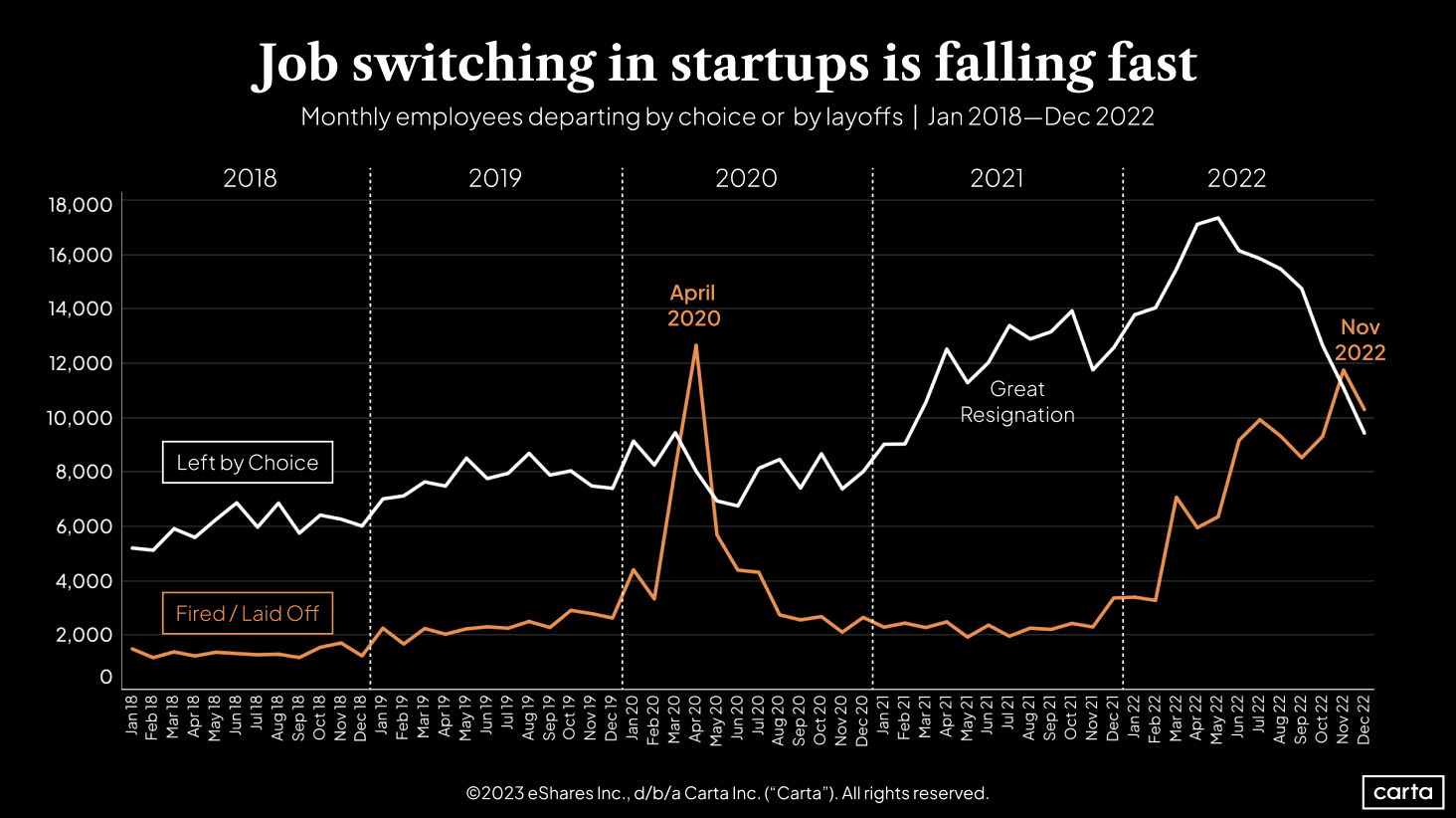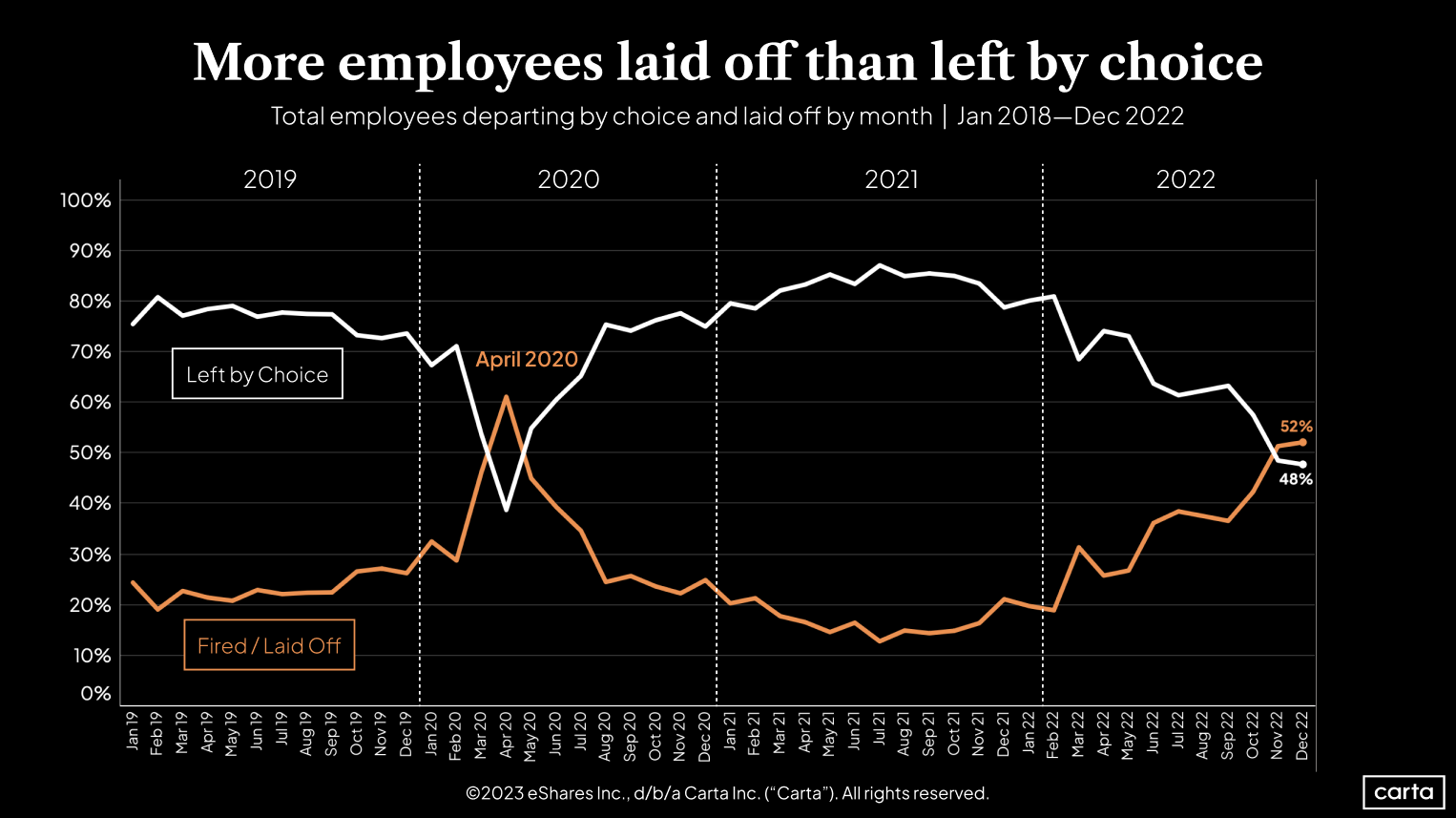The Great Resignation has come to an end, and tech workers have stopped hopping jobs at record rates. Now, they simply want to keep the jobs they currently have.
The monthly number of workers on Carta’s platform who left their jobs by choice increased by 116% over the 18-month span of December 2020 to May 2022. But those days are gone. Since then, the count of voluntary departures has declined every single month, falling a total of 46%. Meanwhile, the number of workers who were laid off or fired has climbed precipitously, spiking 202% between January 2022 and December.
It’s a stark reversal: Starting in November, when a tech worker left their job, it was more likely to be an involuntary departure than a voluntary one. It’s the first time this inversion has occurred since the period of mass layoffs that accompanied the declaration of a global pandemic in the spring of 2020.

A shifting tech job market
In 2021, the market for startup investments was flying high, layoffs were few and far between, and many big tech companies were in the midst of hiring sprees. But in 2022, deal counts were shrinking, valuations were falling, fears of a recession were mounting, and layoffs were on the rise—tech companies laid off more than 50,000 workers in November alone. In January 2023, the layoff count topped 80,000.
In that sort of climate, fewer tech workers are choosing a job change.
“During the Great Resignation, there were candidates that were jumping from job to job because they had the bargaining power,” said Savan Hacknorath, senior vice president of people at Extend, a fintech startup that helps banks and other financial institutions manage virtual card payments for small businesses. “But now, I think that sort of frenzy is over. We’re seeing that thousands of tech workers have been laid off. And so we’re entering this period of great uncertainty.”
This shift is in line with historical norms in the broader economy. Over the past 20 years, worker quit rates have increased gradually during periods of economic expansion and decreased sharply during downturns, according to data from the U.S. Bureau of Labor Statistics.
But this year’s shift in the tech job market has been much more abrupt than in the economy at large. While optional job departures on Carta are down 46% since May, the economy-wide quit rate has only dipped from 2.8% to 2.7% over that span, per the Bureau of Labor Statistics. And while layoffs have spiked among the tech companies on Carta, the economy-wide layoff rate only rose from 0.9% to 1% over the course of 2022.
Layoffs overtake voluntary departures
Since the start of 2019, the rate of employees tracked on Carta leaving a job by choice has almost always been substantially higher than the rate of workers being fired or laid off. The lone exception was April 2020, immediately after the onset of the pandemic, when the U.S. economy lost more jobs than in any single month since the Great Depression.
But this trend, too, has shifted. It peaked in July 2021, when 87% of job departures on Carta were by choice and 13% were layoffs or firings. That gap shrunk over the next several months. Now, it’s vanished entirely: Involuntary exits made up 51.4% of all departures in November 2022, surpassing the frequency of voluntary exits for the first time since the onset of the pandemic.

What comes next?
The number of layoffs ticked down slightly during the holiday month of December. But news of job cuts at massive tech companies has continued in 2023. Salesforce announced thousands of layoffs, Microsoft revealed plans for some 10,000 cuts, and Amazon decided to let go of thousands more workers than initially planned. Overall, more than 250 tech companies have already laid off workers this year. Some think layoffs in the tech sector will get worse.
On the other hand, there’s some reason to think that fears of economic upheaval have already peaked. Interest rates are still on the rise, but the Federal Reserve has started reducing the size of its recent hikes. Inflation is slowing. Goldman Sachs recently pegged the odds of a recession in the next 12 months at just 25%. And the broader job market remains tight: In January, U.S. employers added 517,000 jobs and the national unemployment rate fell to 3.5%, reaching its lowest point since the 1960s.
But for now, at least, workers are still leery about layoffs. As long as those fears persist, the rate of job-hopping should continue to shrink.
Get weekly insights in your inbox
The Data Minute is Carta’s weekly newsletter for data insights into trends in venture capital. Sign up here:
